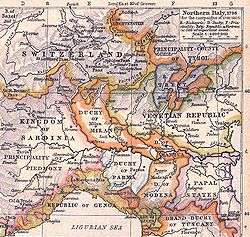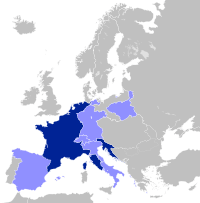Cispadane Republic
| Cispadane Republic | ||||||||||||
| Repubblica Cispadana | ||||||||||||
| Client state of France | ||||||||||||
| ||||||||||||
|
| ||||||||||||
 Northern Italy in 1796; Modena and Papal Legations (all lower right) were merged into the Cispadane Republic | ||||||||||||
| Capital | Bologna | |||||||||||
| Languages | Italian | |||||||||||
| Government | Constitutional republic | |||||||||||
| Legislature | Legislative Body | |||||||||||
| • | Upper house | Council of Thirty | ||||||||||
| • | Lower house | Council of Sixty | ||||||||||
| Historical era | Napoleonic Wars | |||||||||||
| • | Congress of Modena | 16 October 1796 | ||||||||||
| • | Treaty of Tolentino | 19 February 1797 | ||||||||||
| • | Cisalpine Annexation | 9 July 1797 | ||||||||||
| • | Treaty of Campo Formio | 17 October 1797 | ||||||||||
| Currency | Bolognese lira | |||||||||||
| ||||||||||||
The Cispadane Republic (Italian: Repubblica Cispadana) was a short-lived republic located in northern Italy, founded in 1796 with the protection of the French army, led by Napoleon Bonaparte. In the following year, it was merged with the Transpadane Republic (until recently the Duchy of Milan) to form the Cisalpine Republic. These were French client states organized by Napoleon after the Battle of Lodi in May 1796. The republic's name refers to the "near side" of the River Po.
On 16 October 1796, a congress was held in Modena after the ruler, Duke Hercules III, had fled to Venice to escape the French advance. The congress was formed by representatives from the provinces of Modena, Bologna, Ferrara and Reggio Emilia, all located south of the Po. The congress was unofficially organized by Napoleon, whose French army had swept through northern Italy earlier in the year, and who needed to settle the situation in Italy and gather new troops for an offensive against Austria. The congress proclaimed that the four provinces would form the Repubblica Cispadana and invited other Italian populations to join them. A civic guard, composed of mounted hunters and artillery, was formed. In the 7 January 1797 session, in Reggio Emilia, the congress decided to form a government. The flag, the first tricolore in Italy, was a horizontal tricolour, with red (top), white and green stripes. In the center was an emblem composed of a quiver, accolade to a war trophy, with four arrows that symbolized the four provinces forming the Republic, all within a crown of bay.
According to its constitution, the Republic was to be governed by a directory based on the French Directory; it had a bicameral parliament composed of a Council of Sixty and a Council of Thirty, and was divided into departments after the French model and comuni (municipalities).
On 9 July 1797, the Cispadane Republic united with the Transpadane Republic to form the Cisalpine Republic.

